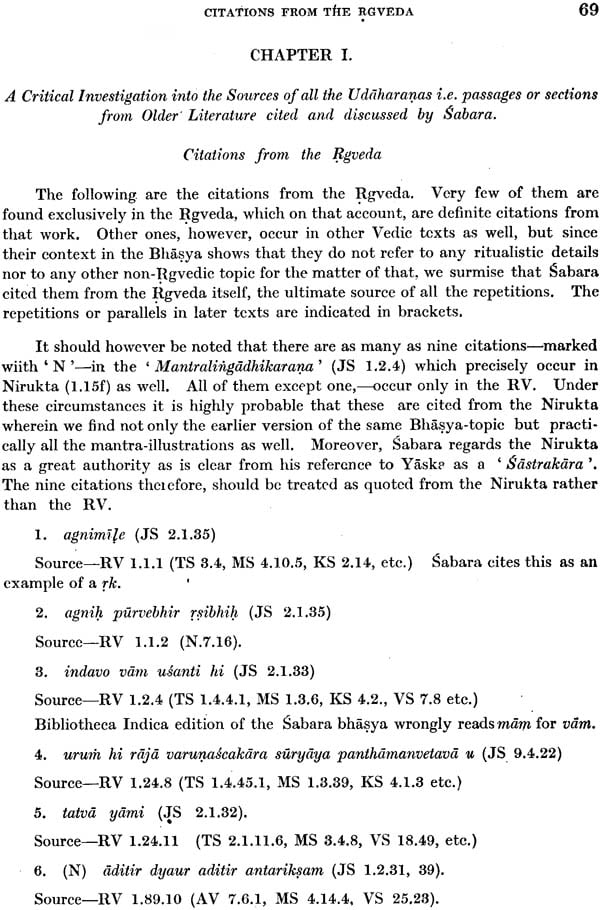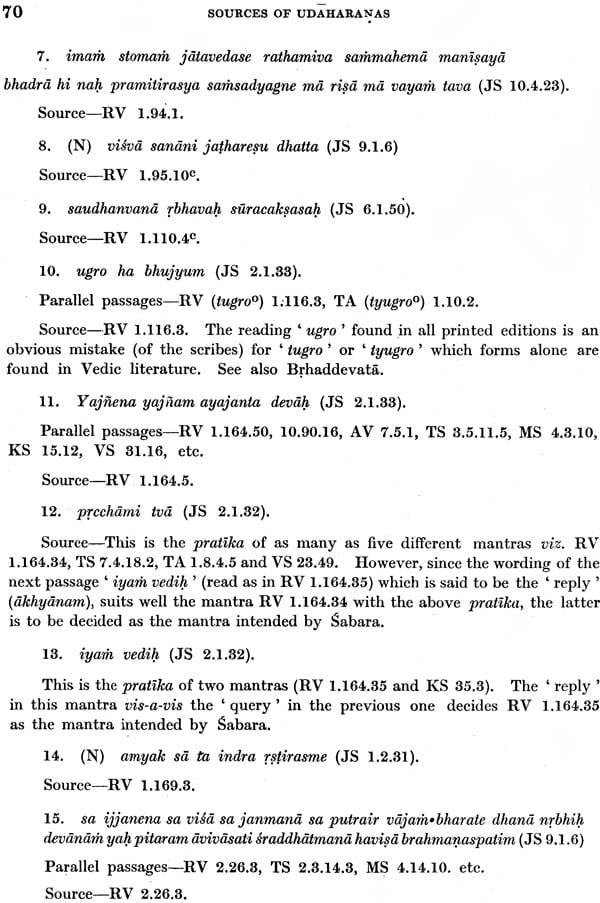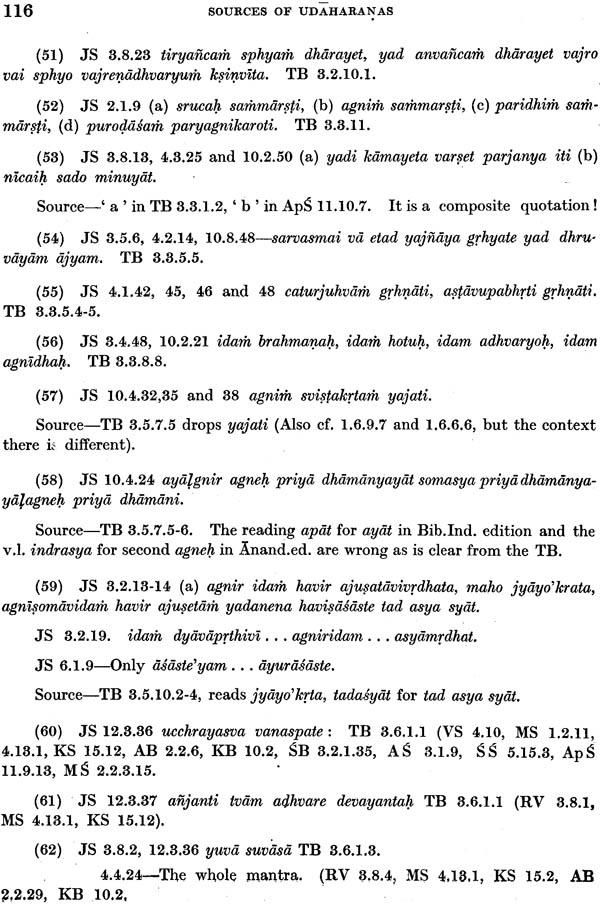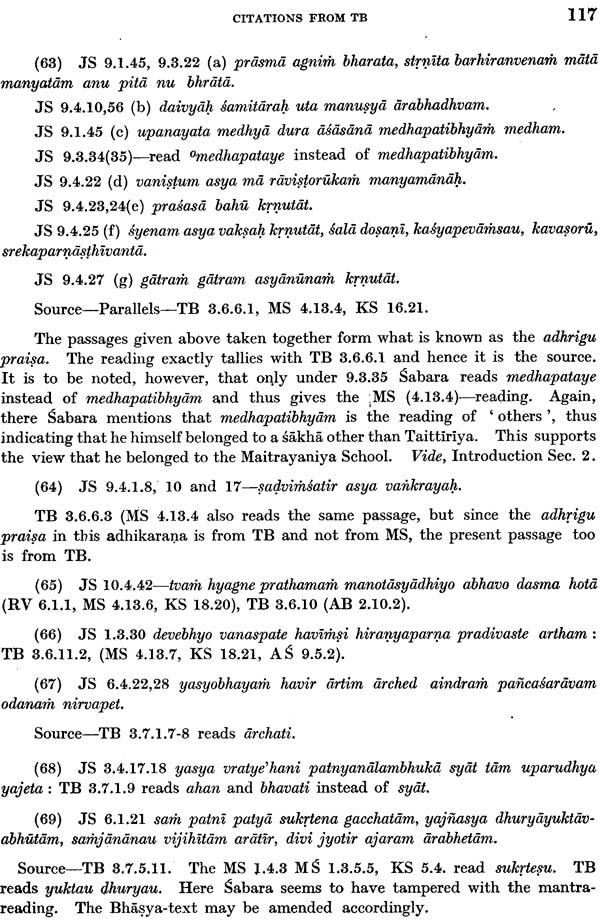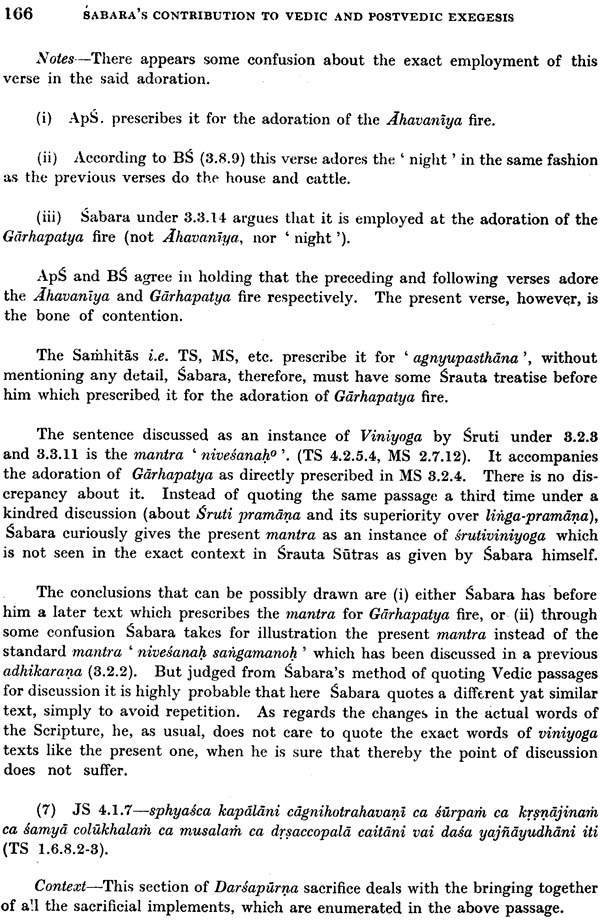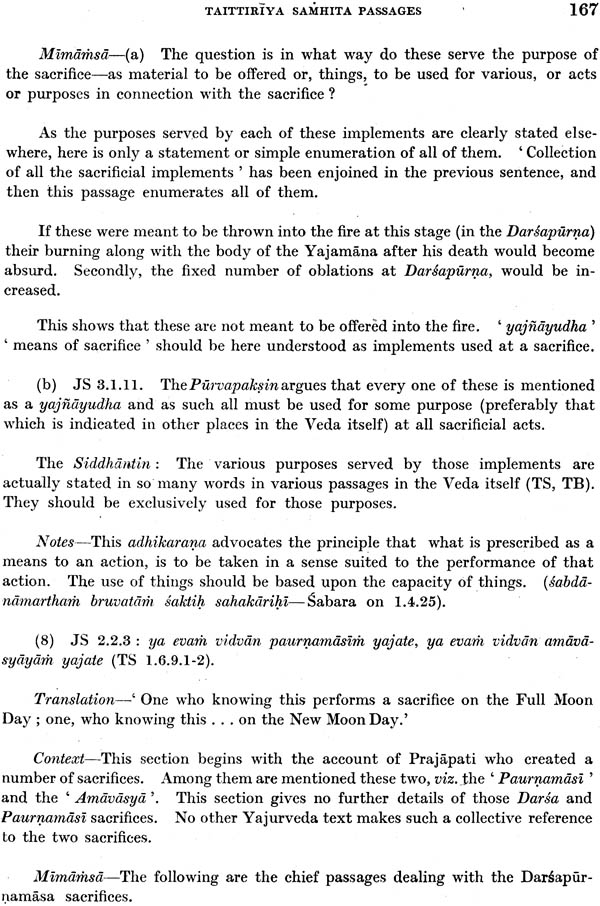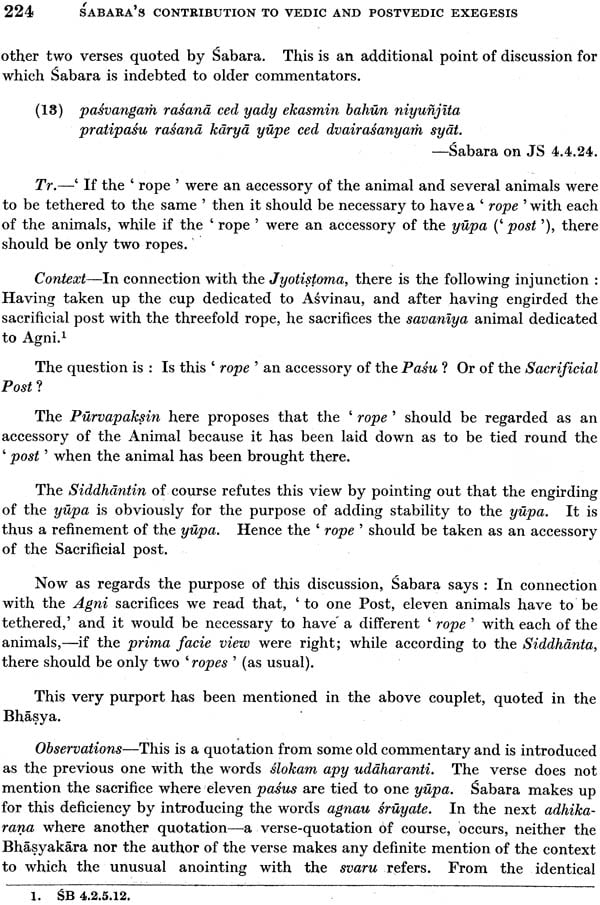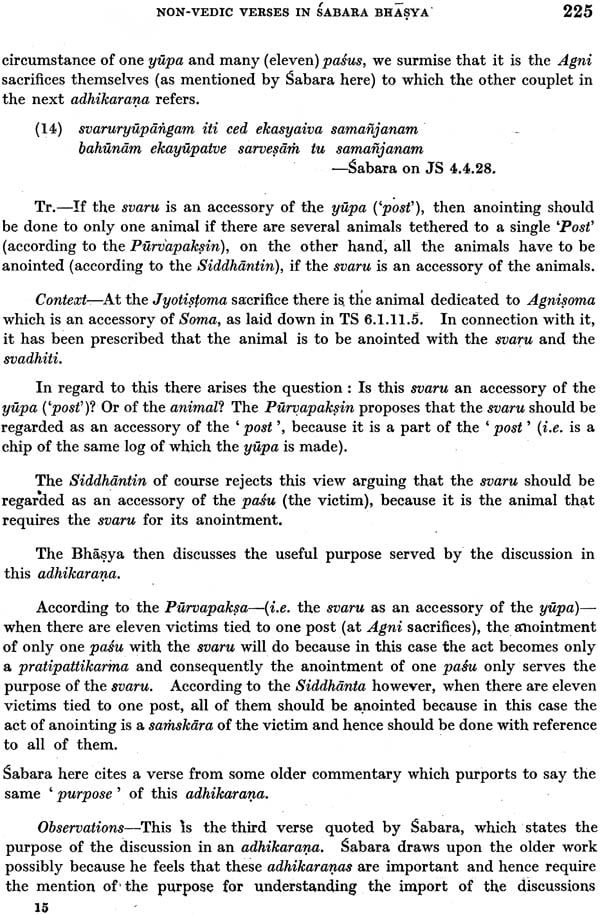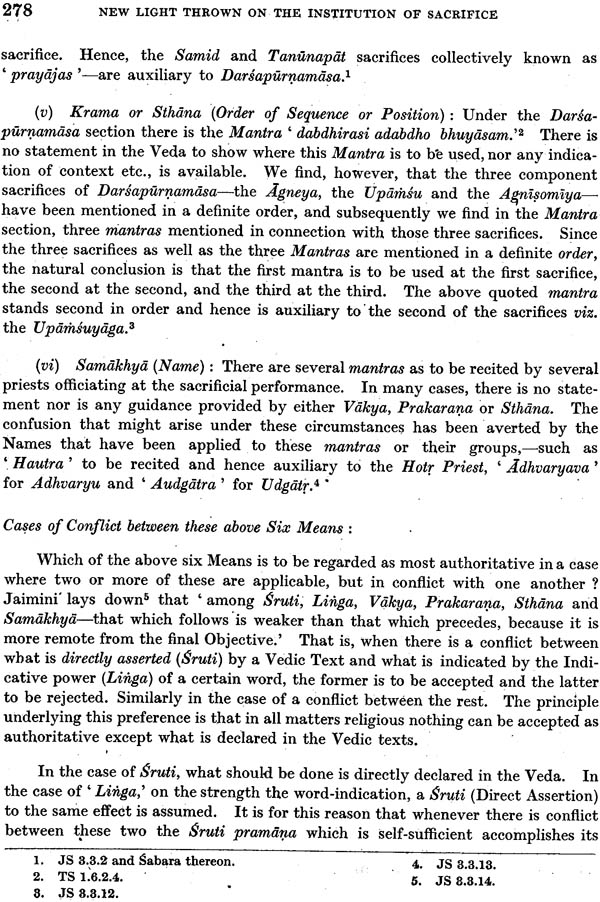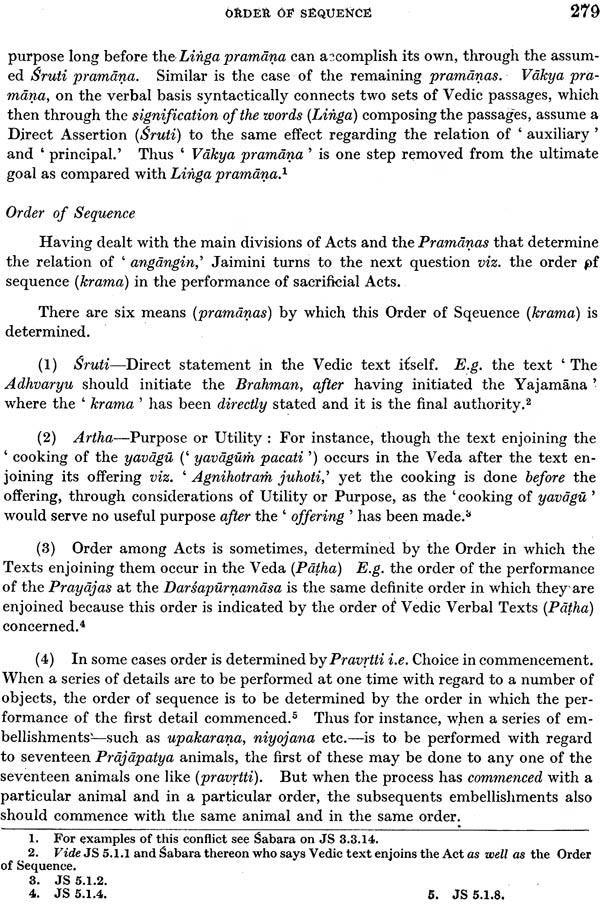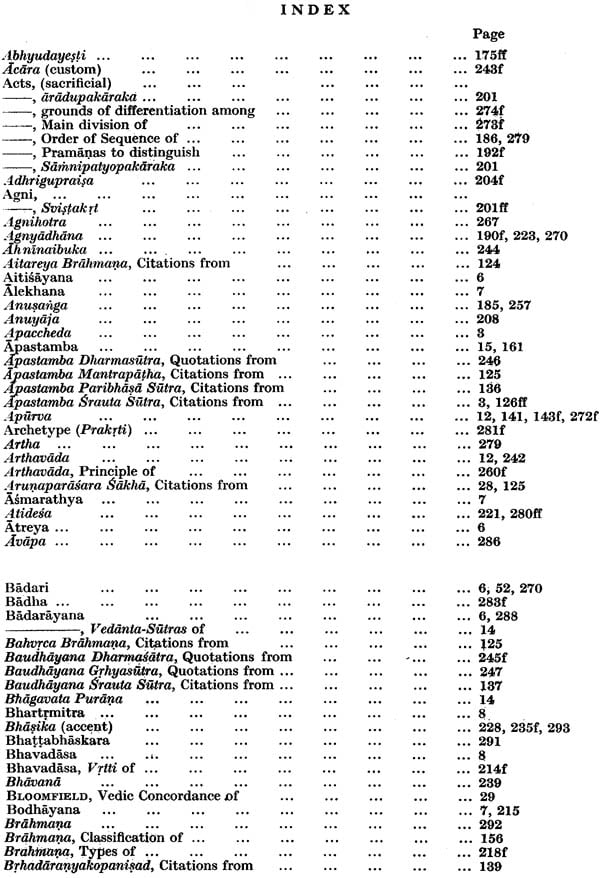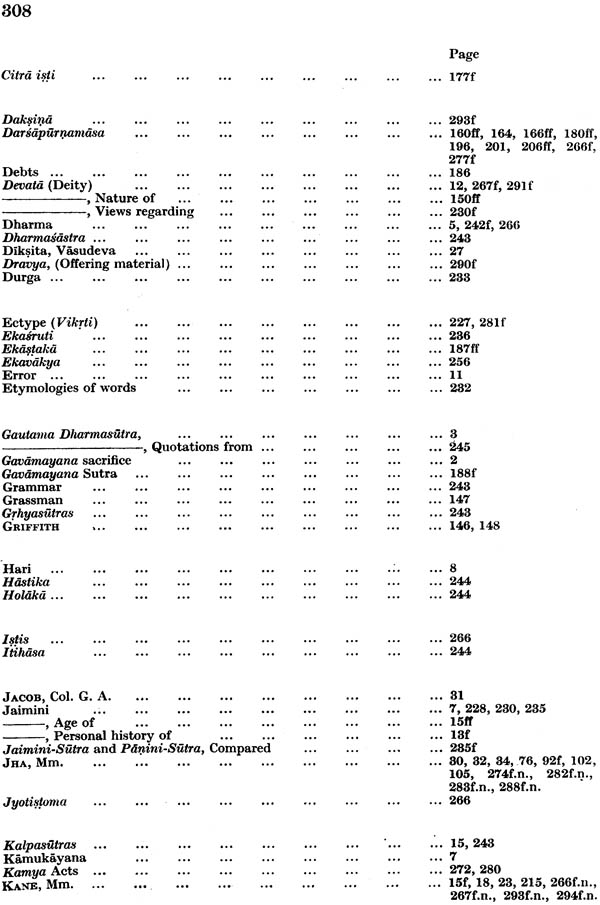
Citations in Sabara-Bhasya (A Study)
Book Specification
| Item Code: | NAJ056 |
| Author: | Damodar Vishnu Garge |
| Publisher: | Deccan College Postgraduate and Research Institute |
| Language: | English |
| Edition: | 1952 |
| Pages: | 326 |
| Cover: | Paperback |
| Other Details | 9.5 inch x 7.5 inch |
| Weight | 430 gm |
Book Description
Early in 1939, when I began to study the Bhasya of Sabara on the Purva- Mimamsa-Sutras of Jaimini, I was deeply impressed by the scientific method of discussion evolved by the Purva-Mimamsa Sastra for the interpretation of- Vedic Texts. After a continued study for a year and a half, I had the good fortune of joining the Deccan College Post-Graduate and Research Institute, Poona, which provided facilities for research to young students. Dr. V. M. ApTE, then Professor of Sanskrit at the Institute, suggested to me the theme of the present work as a subject for Ph.D. Thesis and enabled me to complete my work on it.
Judging from the number of scholars, eastern and western, engaged in the field, the Purva-Mimamsa is one of the less favoured. Darsanas, However, the monumental work of Jaimini together with Sahara's Bhasya thereon is next in importance only to Panini-Sutras with Patanjali's Mahabhasya on them. Though Jaimini in his Purva-Mtmamsa Sutras refers to many predecessors, he may for all practical purposes be looked upon as the fountainhead and inspiration of the whole development of the Mimamsa-Sastra, in so far as clear literary evidence of such development is available. The Sutras of Jaimini have superseded the works of all his predecessors, and dominate the Mimamsa activity of all its successor. The sutra-style of Jaimini is enigmatic, condensed and involved. There i no literary record of the explanations that must have accompanied the Sutras of Jaimini in their oral transmission from teacher to pupil. Fortunately, a guide to the interpretation of these Sutras is available in the immense and unique Bhasya by Sabara thereon. It is the earliest and the most authoritative exposition of the Sutras of Jaimini and therefore of the Mimamsa Sastra. Another fortunate circumstance is that we are not confronted with more than one equally authoritative Bhasya on the Sutra of Jaimini, as in the case of the Sutras of Badarayana, each claiming to represent correctly the meaning of the Sutras. It is, therefore, possible, to look upon the Sutras and the Bhasya as a single homogeneous work from the point of view of my investigation in the present book, which is primarily concerned with a study of the Bhasya.
In this Bhasya, Sabara cites over two thousand passages and sections by way of quotations in an identical, abridged, amplified or adapted form or by way of references, implicit and explicit, from older literature-Vedic and Post-Vedic. The Bhasya draws upon these by way of udaharonas, for purposes of illustration and explanation, in expounding the purport of the Sutras. A large number of these quotations may be supposed to be implicit in the Sutras of Jaimini, having been left to be explained orally by the teacher, as their very condensed form precluded any direct verbatim quotation. Close scrutiny, however, reveals a small but very important class of quotations among these, pratikas (abbreviated symbols) or otherwise. To as "Sutra citations" to distinguish them Bhasya and referred to as Bhasya citations.
Prof. Dr. V. M. APTE drew my attention to the fact that these citations open up a new field of investigation, viz. an assessment of the contribution of the Purva- Mimamsa to the interpretation of all Vedic and Post-Vedic Texts from which the citations are extracted as also of its contribution to the systematization of the Institute of the Sacrifice (or Dharma), which is represented in the Texts drawn upon as a diffuse mass" of complicated and apparently contradictory injunctions and rules. The investigation in the following pages, therefore, undertakes the evaluation of the Sabara-Bhasya from these two important points of view, because the exegesis of the passages extracted and the clarification of the sacrificial procedure illustrated with their aid, are interdependent.
The present book is divided into three parts: (1) Introduction (2) Udaharana Material, (3) Appendices.,The first part, sub-divided into ten Sections first deals with some necessary preliminary historical surveys and general principles, and then states in advance a symposium of the important results of the investigation.
The second part examines in detail, the Udaharana Material from the point of view of Sabara's contribution to the exegesis of the Source-Texts of the Udaharanas and systematization of the ritual prescriptions of Vedic sacrifices.
As a preliminary, the First Chapter seeks to trace all citations in the Bhasya to their sources because the Purva-Mimamsa point of view in the exposition of the Udaharanas (i.e. the cited passages) can be understood only when the original contextual setting of the passages under discussion is known. When it is not possible to trace a passage to any extant Vedic Text, and when its source is probably some lost Vedic Text, suggestions are offered regarding the probable literary category of such a Text. The total number of passages investigated into is about 700. These have been grouped according to and' in the order of importance of the source-texts.
As regards the untraced passages, a large number of these turn out to be mere jejune quotations which appear to have been extracted from some sacrifical manuals used by Sahara and no longer extant.
In the Second Chapter the Udaharana-material has been examined with a view to assess the contribution of the Sabara-Bhasya to the exegesis of the older Texts, Vedic and Post-Vedic, determined as sources of the Uddharanas, in the First Chapter.
Interspersed in the body of the Bhasya which sets before itself the task of an enquiry into Dharma are found rules or canons of textual interpretations framed by the Purva-Mimamsa School. They have been illustrated in the Bhasya invariably by appropriate passages from older literature. Although in accordance with the main aim of the Purva-Mimamsa these canons have been principally applied to texts on sacrifice, they are of so general and universal a character that they are used even today in India for the interpretation of legal texts and commentaries and the settlement of doubtful points raised therein. The validity of these canons, the immediate use to which they are put and their utility for all times, have been critically discussed in the Third Chapter.
The results of the writer's investigation into all Bhasya-discussions of problems connected with the Sacrifice, its theory and practice,-have been presented in detail in the last Chapter.
In the third part, are included all Appendices. The Citations in the JS (i.e. the Sutra-citations) have been listed in Appendix I wherein the source-texts also are pointed. Appendix II gives an Index of citations that are not recorded in any of the Indices published so far. Appendix III gives an alphabetical Pratika-Index of citations (excluding the jejune ones) in the Sabara-Bhasya, which have been traced to their sources for the first time by the present writer. A general Index is given at the end of the book.
Before I conclude, it is my pleasant duty to acknowledge my debt to various persons and institutions, who have laid me under deep obligations. In preparing my book, I had naturally to consult and draw upon numerous works. As far as possible, I have indicated my indebtendness to all my authorities in the footnotes, or, in some cases, in the body of the book.
I record here my deep gratitude to my Guru Prof. Dr. V. M. APTE, M.A., Ph.D . (Cantab.), who first initiated me into Sanskrit Research and was kind enough to render me valuable advice throughout the period for which I was engaged on this work.
Next, I am greatly indebted to the Deccan College Post-Graduate and Re- search Institute, Poona,-particularly its Director, Dr. S. M. KATRE, M.A., Ph.D., for giving me every possible help in books and scholarships in the course of my study. My thanks are also due to Pt. D. K. TAMBE, Mimamsa-Kovida, the Superintendent of the Mimamsa Vidyalaya, Poona, for his uniform courtesy and kindness in allowing me to use the Library of the Vidyalaya.
So far as the printing of the book is concerned I am glad to acknowledge once more my debt to Dr. KATRE for his kind consent to, include the publication in the Institute's Dissertation Series. But for this arrangement, I am doubtful whether the work would have appeared in print.
Next, I have pleasure in acknowledging my indebtedness to the Universities of Poona and Bombay for grants-in-aid received by me from these Universitie towards the co t of publication of this work. Lastly, I take this opportunity of acknowledging my debt to the Trustees of the Ichalkaranji Education and Charitable Trust, who generously donated a sum towards the publication of this book .
Truth was passionately pursued in Ancient India. Vedic literature which is replete with free discussions on material and spiritual topics, carried on by individual sages or their assemblies, bear ample testimony to this quest after truth,- discussions which gradually led to the development of rationalistic and mystical tendencies culminating into the evolution of the six important Darsamas among which the Purva and Uttara Mimamsas figure prominently.
Discussion and cogitation concerning the true nature of things, material or spiritual, form the very backbone of ' Mimamsa ' which analyses thought-processes and examines the pros and cons of a problem with a view to arrive at the right conclusion. Inquiry, doubt, scruple and objection serve as the most powerful means to get at the ultimate truth or reality.
In the Rgveda in which we naturally seek the earliest, traces or rudiments of the 'Mimamsa,' doubts are raised and inquiries started regarding the ultimate truth on a religious as well as a philosophical plane. On the religious plane, we notice that doubts were expressed regarding the power and even the very existence of the gods. Thus, in RV 8.100.3f., where the priests are invited to offer a song of praise to Indra, the poet says: "A true one (hymn), if in truth, Indra as such exists; for many say: 'There is no Indra. Who has ever seen him? To whom are we to direct the song of praise? '''-Whereupon Indra personally appears, in order to give assurance of his existence and greatness: "There I am, singer, look at me, here; I towel' above all things." Similarly, there is a religious riddle of mythological content found in the hymn RV 8.29, wherein each stanza describes the characteristic marks of a deity, the name of which is offered as a problem -a problem of the very type that we find discussed in the Purva Mimamsa; for example under JS 2.1.13-16 it has been established after discussion that the deity which is lauded in the hymn' abhi tva sura nonumah ' (RV 7.32.22, TS. 2.4.14.2a), is ' Mahendra' and not ‘Indra.' In another hymn (RV 10-121) in which the refrain occurs verse after verse: "Which god shall we honour by means of sacrifice?"-there is the thought-provoking inquiry regarding the One and Only God deserving of worship. The answer is that Prajapati, the creator and preserver of the world, deserves worship. These inquiries are reminiscent of later discussions in the Purva Mimamsa.
Coming to the philosophical plane we notice the same idea of One God expressed clearly in the verse RV 1.164.46 "They call him Indra, Mitra, Varuna and Agni; he is the heavenly bird Garutmat. To what is one the poets give many a name. They call it Agni, Yama, Matarisvan."1 Herein is foreshadowed the idea. That what are popularly known as "gods" are, in reality, only emanations of the One and only God; that all plurality is imaginary. Some three or four hymns of the RV consist of speculations on the origin of the world through the agency of a Creator as distinct from the ordinary gods. The scepticism regarding this problem finds its most powerful expression in the Hymn of Creation (RV 10. 129). It begins thus: "There was not the non-existent, nor the existent then; there was not the air nor the heaven which is beyond. What did it contain? Where? In whose protection? Was there water unfathomable, profound? "
The poet then ventures on a reply to the querry. Water, he says, came into being first, from it was evolved intelligence by heat. Again, he asks: "Who knows truly? Who shall here declare, whence it has been produced, whence is this creation?" (v" 6). The investigation in the above hymn is the starting point of the natural philosophy which developed into the Sankhya System and which in part was acceptable to the Uttara Mimamsa (or Vedi1nta)-a complementary system of the Purva Mimamsa.
It will be clear from the above discussion that the germs of 'Mimamsa '- Purva and Uttara-, are found in the hymns of the RV, though the word' Mimamsa ' had not yet made its appearance.
The term' Mimamsa ' occurs, not rarely in the Yajurveda Samhitas, and the Brahmanas, in the sense of a ' discussion,' on some point of ritual practice. The sacrifice which was supposed to be the most efficacious system of worship offered innumerable opportunities for divergence of practice in detail, and the texts have to decide in favour of one or the other alternative on the strength of arguments familiar to the Brahmanas, Thus in TS 7.5.7.1 it is said, " the expounders of Brahman discuss (‘mimamsante') whether (a day) at the Gavamayana sacrifice should be omitted or not'; on this they say, ' It should be left out. It should be left out at the new moon and at the full-moon for these two guide the sacrifice.' These two must not be left,' (others) say, 'for these two determine the dependent sacrifice.' (The conclusion then follows) the day should be left out on the first vyastaka, for this is what rends the month. They should not however leave out a day which is appointed." Herein is the oldest use of the derivative verb-form ‘mimamsante' in the sense of 'investigating a doubtful point and arriving at a conclusion thereon.’ In numerous other places similar doubtful points introduced by the words, 'the expounders of Brahman say,' are put forward without employing the word' mimamsante,' e.g. TS 2.5.3.7.1 In KB 26.3, the word' mimamsante' introduces a controversy between Paingya and Kausitaki regarding the form of the prayascitta for a flaw in the recital of a sastra at the Go-Ayus sacrifices.
In the Upanisads we frequently meet with expressions like 'mimamsam cakruh.' and ‘anandasya mimamsa.’ In the Kenopanisad (2.1) the noun-form ‘mimamsya ' with the suffix ‘yat ' is found employed. From all these quotations and references, it is clear that the verb ‘mimamsante' and the word ‘mimamsa’ had from the remotest times to the times of the Upanisads been employed in the sense of discussions of doubtful points whether in ritual or in philosophy.
The antiquity of the Purva Mimamsa as a System is vouched for by the Srautasutras which, in their attempts to systematise and simplify the intricacies of Vedic ritual, presuppose certain traditional principles of interpretation, well- known to earlier generations of Vedic Schoolmen,-principles that are found crystallized in the Purva Mimamsa Sutras of Jaimini. Thus the line of reasoning followed by Apastamba (ApS 14.26.8) in establishing his view regarding 'the expiation for the 'apaccheda' at a Soma-sacrifice' is the same as that embodied in the rule of Jaimini (6.5.54f).5 Both of them maintain that when (in a Soma- sacrifice) the priests go out of the sacrificial hall for singing the bahispavarmana hymn, if two of the priests break the line (' apaccheda ') one after another, the expiation (prayascitta) performed should be one laid down in connection with the flaw committed a second time, for' when two faults occur consecutively, the former is weaker.' There are not less than one hundred similar topics scattered over all the Srautasutras, that have their exact counterparts in JS! What is more worthy of note is that some passages in the Srautasutras textually agree with their parallels in JS. Thus an identical version of ApS 24.2.36-38 (i.e. ApPS 2.36-38) is found in JS 4.4.19-21 wherein it is established after discussion that though the Pinda-pitr rite and the Darsa sacrifice are performed on one and the same day, the former is not a part (anga) of the latter." An examination of the Dharmasutras also, from this point of view, is not less interesting. Some of the Dharmasutras contain purely Mimamsa rules and doctrines. The Gautama Dharmasutra says (1.5.) ‘When there is a conflict of two texts of equal potency, there is an option.' The same rule is found in JS 12.3.10. Apastamba (ApDS 1.1.4.8) says, 'a positive Vedie text is more cogent than usage that leads to the inference of the existence of a Vedic text.' This resembles Jaimini's dictum (1.3.3). Apastamba in two passages (ApDS 2.4.8.13 and 2.6.14.13) disposes of contested points by the authority of those who know the' nyaya,' a term which seems to have been applied to the maxims of Mimamsa. An explicit mention of the Mimamsakas first occurs in the Mahabhasya of Patanjali who also speaks of a Brahmani who studied the Mimamsa propounded by Kasakrtsni.
These considerations enable us to assert that centuries before the Christian era the doctrines of the Purva-Mimamsa had been well developed and that they had been embodied in the form of works before the time of Patanjali ( 150 B.C.). 4 Thus simultaneously with the modelling of the Srauta- and Dharmasutras, there must have proceeded the attempts to form the rules of interpretation of Vedic texts until they were finally codified in the Purva-Mimamsa-Sutra which passes under the name of Jaimini. Though the details of the process must remain un- known to us, it is certain that the Mimamsa Siitra of Jaimini presupposes a long history of discussion, and that its aphorisms which often assume, without ex- pressing, general rules of interpretation, deal largely with difficulties affecting individual Vedic texts which had long been the subject of dispute.
Though Jaimini in his Purva Mimamsa Sutra refers to many predecessors, he may for all practical purposes, be looked upon as the fountain-head and inspiration of the whole subsequent development of the Mimamsa Sastra, in so far as clear literary evidence of such development is available as he has superseded (into oblivion) the works of all his predecessors whoever they were.
The Extent and Arrangement of the Purva-Mimamsa-Sutra
Jaimini's Purva-Mimamsa-Sutra is divided into twelve chapters, each chapter devoted to one particular topic, due to which the whole work is also designated as ‘Dvadasa-laksani.' Prapancahrdaya, a late work of an unknown author (which according to S. K. Aiyangar belongs probably to the tenth century A.D.), states that Sankarsakanda (also known as Devatakanda) consisting of four chapters also formed a genuine part of the Jaimini-Sutra and was commented upon by When Sabara refers to a portion of Jaimini's work as ' Sankarsa,' he probably refers to this very Sankarsakanda. Unfortunately his Bhasya on that portion is not available. Now Kumarila who carefully notes the number of the sutras of Jaimini passed over by Sahara and explains the absence of a bhasya thereon, was not expected to omit a reference a whole kanda like the Sankarsa as uncommented on by Sabara, Besides, a work bearing the title Sankarsakanda and provided with a commentary called Bhatta- candrika is not an authentic work.
The twelve chapters of the JS are further divided into sixty padas, the third, sixth and tenth chapters having eight padas each in lieu of the normal four. In Madhava's reckoning there are 2745 sutras grouped into 915 adhikaranas.
The Contents of the Purva-Mimamsa-Sutra
The aim of the Purva-Mimamsa, says Jaimini, is the correct knowledge of 'Dharma.' It is laid down that' Dharma' is that which is described in all statements which refer to any kind of sacrificial activity whether such statements are met with in the Vedas or in popular parlance. As the Veda is the only source of and authority for our knowledge of the details of all sacrificial procedure comprised under Dharma, determination of this procedure is not possible without a correct interpretation of the authorities viz. the Vedic texts. When, therefore, the Purva- Mimamsa Sastra undertakes the settlement of all the sacrificial problems raised by Vedic passages of sacrificial import in the interest of a knowledge of Dharma, the clarification of sacrificial ritual and hermeneutics, both naturally fall within its purview. The arrangement of the topics in JS is, therefore, as follows: The first chapter deals with the pramanas of Dharma, and the relative authority of the Sruti, Smrti and Sutra texts so far as the correct knowledge of Dharma is concerned; the second deals with the theory of apurva which alone helps in deciding the nature of ritual acts, whether they are 'principal' or 'subordinate '; the third deals with 'angatva,' the fourth, the prayojya-prayojakatvabhava, the fifth, the ‘krama' i.e. order of the ritual acts, the sixth, the adhikara-i.e. the qualifications of a sacrificer etc. ; the seventh and eighth the atidesa i.e. the transfer by extension of sacrificial minutre from one ritual act to another; the ninth uha (modification), the tenth, badha (annulment of the ritualistic details); the eleventh and twelfth, tantra and prasanga (centralisation and extended application of the ritualistic details) respectively. These constitute the most important part of the Purva-Mimamsa System.
Principal Acaryas of the Purva-Mimamsa
Though the earliest available work in the systematised form of the Purva- Mimamsa is the Sutra-work of Jaimini, he was preceded by several acaryas of Purva-Mimamsa. Jaimini mentions in his work as many as eight acaryas by name and refers to others by, eke' (JS 9.3.4). These pre-Jaimini Mimamsakas, whether they had written any work on Mimamsa or not, were undoubtedly great teachers of Mimamsa and some of them held independent views on the subject.
| Preface | v |
| Contents | ix |
| Bibliography | x |
| Abbreviations | xi |
| Introduction | 1 |
| Sources of Udaharanas | 69 |
| Sabara’s Contribution to Vedic and Post-Vedic Exegesis | 140 |
| Principles of Textual Interpretation employed by Jaimini and Sabara | 252 |
| New Light Thrown on the Institution of Sacrifice | 266 |
| Appendix I | 297 |
| Appendix II | 298 |
| Appendix III | 303 |
| Index | 307 |
| Corrigenda | 313 |
